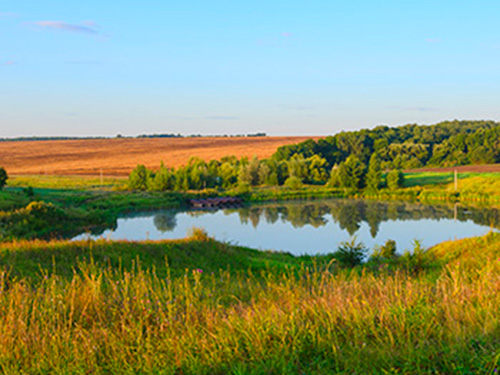Pond Maintenance 101
May 19, 2025

Pond maintenance requires a little bit of research before you start. Knowing the size of the pond, using proper preventantative maintenance products, and properly identifying any growth are key factors in successful pond management.
When you need to treat your pond, knowing the size is essential for applying the correct dosage of all pond maintenance products.
How To Measure the Size of Your Pond
• Square or rectangle ponds – multiply length x width, then divide by 43,560
• Round ponds – multiply diameter x itself, then divide by 547,390
How to Measure Pond Depth
1. Get a long piece of PVC pipe and mark 1-foot increments on it using a waterproof marker.
2. Take depth measurements uniformly across the pond.
3. Add the measurements together and divide by the number of measurements taken.
4. This will give you the average depth in feet.
Now that you know the size of your pond, start applying preventative maintenance products in early spring as soon as the water thaws. Use Azure Blue and pond bacteria at the rate of 1 gallon per acre with an average depth of 4-6 feet deep. Both products are easy to use and set your pond up for the most success. Pour both products in and continue to use these products monthly or when color fades.
Monitor the condition of your pond as temperatures increase leading into summer. Pond algae and weeds will start to form when water temperatures increase. Before you treat, you should properly identify growth. Consult your local Co-op for resources on identifying growth.
Keep these questions in mind when trying to identify your pond weeds:
1. Where is the weed growing? Is it on the surface, under the water, or around the shoreline?
2. Is the plant rooted, or does it float freely around on the surface? You may have to pull at it to find out.
3. What color is the plant? Light green, dark green, or yellowish?
4. What is the texture and the structure of the growth? Is it a granular substance or a small leaflet floating on the surface? Does it have thick hair, slime-like film, a crunchy feeling or is it more grass like?
5. Does it have an odor that is musky, or does it have no scent at all?
6. What is the condition of your pond water? Is it extremely clear, muddy, or green?
Once growth is identified, you can use aquatic-approved algaecides, like copper sulfate, for algae control or herbicides, like Diquat and Imazamox, for submerged, floating or emerged weeds.
Visit your local Co-op for additional advice and maintenance tips for keeping your pond looking great. For more content like this, check out the latest issue of The Cooperator.